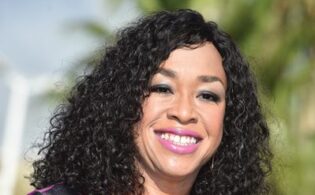CANNES: Shonda Rhimes was interviewed by World Screen’s Anna Carugati on the Grand Auditorium stage for her MIPCOM Personality of the Year keynote, discussing her evolution as a writer and showrunner and her approach to the creative process.
Rhimes said she’s always been a storyteller, since she was a child. She first wanted to be a novelist. “I had big plans to be Toni Morrison, and Toni had that job and you can’t get that job.” Not knowing what to do with her life after college, she went to film school. “It wasn’t until I was there that I seriously thought, I like this! I was mainly trying to find a way to stop working, honestly, and go back to school.”
She started as a film writer in the ’90s. “Television wasn’t as big at the time. Sitcoms were big, it was the Seinfeld era, but dramas weren’t as big at the time. Movies [were] where it was at. Independent film was really big. I thought I would write movies.” Her first produced project was Introducing Dorothy Dandridge for HBO.
She then started writing “teen girl movies” like Crossroads and Princess Diaries II. “I enjoyed it, but there wasn’t a lot of character development going on in those movies.”
Then she adopted a child and spent a lot of time at home, watching television. “I watched an entire season of 24 in 24 hours. I thought, this is where all the character development is happening! I watched three seasons of Buffy in four days.”
She called her agent and subsequently met with ABC Studios (then Touchstone) and first wrote a pilot about war correspondents. “They were having a lot of fun, drinking and being very competitive and having a lot of sex while covering war. And we were at war, so that did not feel very appropriate. The next year I asked, What does Bob Iger want to see? And they said Bob Iger wants a medical show. I love to watch surgeries. I wrote a medical show about people who were very competitive and had a lot of sex. That was Grey’s Anatomy.”
The transition from movie writer to TV writer was a challenging one. “I would spend 300 days doing nothing, 40 days thinking and 15 days writing and one day celebrating the fact that I had written something. Suddenly you have to churn out a script every eight to nine days, and you have 300 people working for you. And you have to run a writers’ room and know what you’re doing. It was zero to 3,000 in an instant.”
Grey’s Anatomy remains a significant hit in the U.S., 13 seasons in. On keeping it fresh, Rhimes said, “Meredith Grey has been on a journey for 13 seasons. It’s not the same show every year. There is a procedural element…[but] it is a character journey. I feel like I’ve been writing a novel for 13 years. Ellen Pompeo and I have been locked together in this very interesting journey for a very long time. Because she is fearless and [says] ‘Show me without my makeup,’ ‘Cut back to me 12 years ago,’ ‘Watch this journey happen, watch me age on-screen,’ we get to watch somebody evolve on camera. I look at every season as if it’s a completely different show. Where is Meredith now and how do we make that story feel interesting and how are we going to tell it?”
At the start of every season she knows how it’s going to end. “We start with the last episode in mind and try to get there.”
Carugati asked Rhimes about her interest in the medical profession, which she said is “filled with life-and-death experiences. On a bad day, you actually kill someone, and on a good day you save someone’s life. There’s something really visceral about that job that I love. I also loved, especially in the beginning, the cutthroat nature of it for women. There were six women out of 20 for every medical class. That was interesting to me, to be in a place where you were so overwhelmed by the men in the program and thought to be less than. There are a lot more women who are surgeons now. But at the time that felt like a fascinating world to enter.”
Carugati later moved the conversation on to Scandal, which originated as Rhimes was already juggling two shows on ABC. Her producing partner Betsy Beers encouraged her to meet Judy Smith, a Washington, D.C. fixer. The meeting was meant to last for 15 minutes—it went for four hours. “I realized there were hundreds of episodes in what this woman did for a living.”
Rhimes then talked about her role on the Shondaland shows that she doesn’t run: How to Get Away with Murder, The Catch and an untitled ABC mid-season project. “My job, when we’re not in the first season and I haven’t created the show and am not running the show, is just to be the dragon in the cage. I’m the dragon that Pete [Nowalk, on How to Get Away with Murder] can release when he feels like he needs some extra power behind him to talk to the studio or the network about something, when he has some creative issues he needs help with.”
Carugati asked Rhimes about her relationship with her actors. “I do think it’s a collaborative process. I don’t think a character is a character until an actor is inhabiting that role…. My contract with all of the actors is, You say all the words as they’re written. However, while I’m not going to change the words, I’m also not going to go down to the stage and tell you how to say them or interpret them. You then get these performances back that inform whatever is going to happen next.”
Nowalk has a different relationship with Viola Davis on How to Get Away with Murder. “There’s a writer in her soul. Viola will pitch scenes. She and Pete are very collaborative. They discuss story lines, they debate them. Pete loves it. It would make my hair stand on end, because of the way my brain takes in story. However, Kerry [Washington] and I have lots of long discussions about things that are going to happen way in the future, because she has such a great head for politics as well, as those things often end up feeding into the story too.”
Rhimes said that the “best and most exciting thing” about running Shondaland is that she can find and develop talent and watch them grow. “I always say, Story is best told by saying, What’s the worst possible [thing] that could happen in this moment to the character and then make that happen and get them out of it. That storytelling you learn really well while working in Shondaland.”
Addressing her own learning curve from writer to showrunner to head of Shondaland, Rhimes said, “Going from thinking about just yourself to thinking about a thousand people [working on five shows] plus the people who work at the company plus all the fans who are watching plus all the people who work at the studio and the network, you become responsible to them and for all the people who work for you.” She said she is just beginning to get a handle on “making sure people feel valued when they come to work, not feel like they’re working, so they’re enjoying themselves at work. Work should be fun, and if work isn’t fun then maybe we’re doing it wrong.”
Writing is Rhimes’ favorite part of the creative process, but there was a time when it wasn’t, as her slate of responsibilities expanded. “My job was to make it possible to have other people do the other things as much as possible to make room for myself to be more of a storyteller most of the time.”
On when and where she writes, Rhimes said, “As long as I have headphones on my head and music in my ears, I can write wherever I am…. My assistants will tell you [that] I say all the dialogue aloud when I’m writing, very passionately, and I act it all out. It’s embarrassing.”





